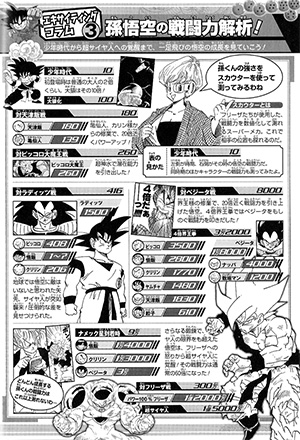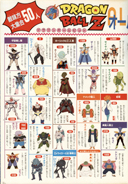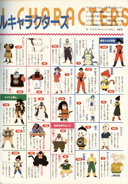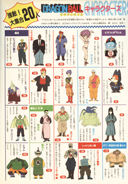This page details all known battle powers from various official sources outside of the manga and anime, but separate from actual video games (which we have categorized into its own page). In this context, “official” refers to companies that have the legal rights to produce Dragon Ball merchandise, including data and guide books. Battle powers on this page are listed roughly in order of the official status of their source — this means that the Daizenshuu are listed at the top, and after them are the Super Exciting Guides, etc. Magazine releases are placed below these.
Battle Powers in the Daizenshuu
Of the hundreds upon hundreds of pages across all ten volume, Daizenshuu 7 is the only one that touches on battle powers in any significant way, and across a mere two pages (82-83): a chart shows the growth of Goku’s battle power throughout the series, with other characters added for comparison purposes. Daizenshuu 7 was published in 1996, a year after the end of the series, and this battle power chart provided readings for characters from both before the concept of battle powers were introduced into the story, and after they basically dropped out of the story mid-way through the battle with Freeza. An odd thing about this chart is that it is placed right in the middle of the character dictionary, right after the pages with the biographies for Goku and the other members of the Son family.
The later guide books Dragon Ball: Landmark and Super Exciting Guide: Story Volume reused Daizenshuu 7′s battle power chart (Landmark even specifically credits Daizenshuu 7). Though all the battle powers are essentially the same (see below for one minor difference), these reprints are both only a single page, and contain shortened versions of Daizenshuu 7′s explanatory notes.
Below is our translation of this section with commentary.
Son Goku came to meet various friends and enemies, who he all eventually overtook in battle. Here you can follow the change in Goku’s battle power from his meeting Bulma and the beginning of his journey, right up to when he became a Super Saiyan on Planet Namek.
At a very young age, Goku demonstrated the power of a martial arts master. However, the blood of the fighting race, the Saiyan, pushed Goku on towards even further battles. The increase in his and the other warriors’ battle power readings knew no end, and before anyone knew it their battles surpassed the mere limits of martial arts, reaching the point where the fate of the world itself was riding on them.
First Appearance: 10
He already has twice the power of an ordinary person. What’s more, his body is tough enough to repel a gun bullet.
Ōzaru: 100
With his battle power becoming ten times its usual, he can even pulverize a 30 cm-thick steel wall. He now has the destructive power of a battleship’s main gun.
22nd Tenka’ichi Budōkai: 180
After experiencing many battles and lots of training, his ability has substantially increased. Losing the championship to Tenshinhan was merely a twist of fate.
Kame-Sen’nin (Jackie Chun): 139
He powered up with training that he kept secret from his pupils. He did his best to build a bridge to the new era.
Tsuru-Sen’nin: 120
He’s the man who had previously held a competitive rivalry with Kame-Sen’nin. However, it seems that in actual ability, Kame-Sen’nin has a slight lead on him.
Tenshinhan: 180
He attacks Goku with superhuman high-level techniques and power, and their contest is nearly even.
Versus Demon King Piccolo: 260
After drinking the Super God Water and awakening his hidden power, Goku’s power is now on par with Demon King Piccolo. Tenshinhan assists him in his death-match with Piccolo.
Demon King Piccolo: 260
He has become even more powerful now that he has his youth restored. Easily capable of blowing away a city, his power rivals that of a small nuclear bomb.
Versus Raditz: 416
Goku joins forces with Piccolo when an unprecedentedly strong opponent appears. However, they’re no match for their opponent in a series battle, and Goku loses his life in exchange for victory.
Piccolo: 408
Unfastening his training equipment, he stands ready to fight at full power. The Makankōsappō that he fires from his fingertips has a power equivalent to 1,330.
Son Gohan: 1~1,307
Although it changes greatly based on his emotions, his hidden power already surpasses his father Goku. He is still only four years old.
Kuririn: 206
Through straightforward training and first-rate talent (for an Earthling), he has surpassed his master Kame-Sen’nin. Afterwards, he holds his own on the battle’s frontline.
Raditz: 1,500
He toys with Goku and Piccolo with incredible power and speed. Despite this, he is still merely a low-level warrior.
Versus Vegeta: 8,000
Receiving training from Kaiō, Goku’s ability has revolutionarily increased. From this time onward, the Kaiō-Ken and Genki-Dama become dependable weapons for Goku.
Saibaiman: 1,200
Vegeta: 18,000
Kuririn: 1,770
Yamcha: 1,480
Chiaotzu: 610
Tenshinhan: 1,830
Piccolo: 3,500
Son Gohan: 2,800
Arrival on Planet Namek: 90,000
Training under gravity 100 times that of Earth, he breaks through the limits of previous Saiyan. In addition, he is now able to endure the Kaiō-Ken up to x10.
Son Gohan: 14,000
Kuririn: 13,000
Vegeta: 30,000
Versus Freeza: 3 million
As a result of having his wounded body healed in a medical treatment machine, Goku achieves a super power-up that astonishes even him. His Saiyan pride now awakened, he faces the decisive battle.
Freeza 50%: 60 million
Freeza 100%: 120 million
After reaching his final form, Freeza overwhelms Goku with only half of his true capabilities. However, he unleashes his full power after the appearance of the Super Saiyan.
Daizenshuu 7′s battle powers for both Freeza’s full power and Super Saiyan Goku are commonly said to be only 12 and 15 million, respectively, while normal Goku is given as 300,000 and Freeza at 50% as 6 million. This misconception most likely traces back to the Ultimate DBZ Information Site, a very influential English Dragon Ball fan site in the 1990s that was run by Greg Werner. On the “Little Known Dragon Ball Z Facts” page, item 26 provides a list of all battle powers from the manga or daizenshuu, and it gives these numbers for Goku and Freeza.
Werner prided himself on creating all of his site’s content, and much of his site consisted of things he took from Daizenshuu 7, so it is unlikely that he relied on someone else to make his list. Countless other fan sites relied on Werner’s site for information (and often took his content verbatim), so this mistranslation spread throughout the English-speaking Dragon Ball fan community. In particular, the popular site Planet Namek also used 12 and 15 million in their power levels list, color-coding them as being from the daizenshuu. It is possible that “SkullMac”, the individual responsible for maintaining Planet Namek′s power list, made the same translation mistake as Werner, but it is more likely that he relied upon Werner’s site for these numbers.
At any rate, how would someone mistranslate these numbers? This is the way those battle powers are written in Daizenshuu 7:
Goku: 300万
Super Saiyan Goku: 1億5000万
Freeza 50%: 6000万
Freeza 100%: 1 億2000万
“万” (man) is the kanji for 10 thousand, while “億” (oku) represents 100 million. If you do the math, “300 man” is 3 million and “1 oku, 5 thousand man” is 150 million. It is easy to see how someone not too experienced with the Japanese number system could make a mistake converting them, especially since all the previous battle powers in this section of Daizenshuu 7 are written purely in Arabic numerals, with no kanji or mathematical conversion required.
Super Saiyan: 150 million
The warrior of legend, the Super Saiyan, finally awakens. In addition to having battle power 50 times that of his normal state, he now overwhelms even Freeza.
Also in the Super Exciting Guide: Story Volume, Toriyama revealed in an interview that he thought a multiplier of 50 was rather large, and that he had originally drawn it with the sense of being a 10-fold increase in what Goku had been “up until then”. It is unclear how this would put Super Saiyan in relation to Goku’s regular use of Kaiō-Ken x10 to gain a 10-fold increase in power, and the “up until then” bit muddies things further. Since Goku had already multiplied his power 10 and 20 times with the Kaiō-Ken as he fought Freeza, did Toriyama mean that he thought of Super Saiyan as being 10 times stronger than that, meaning it would make Goku overall 100 or 200 times stronger than he normally was? If so, it is hard to make sense of Toriyama saying that a 50-fold increase is too large. If Toriyama meant that it only made Goku 10 times stronger than he was without using Kaiō-Ken, then Super Saiyan Goku is only half as strong as he was when using the Kaiō-Ken x20, at which point he was unable to significantly harm Freeza. Perhaps the answer is that Toriyama is being his usual forgetful self, since he himself admits in the same interview to have forgotten much of Dragon Ball′s story himself, and that we should not take these numbers he throws out too seriously.
Even after the battle with Freeza, formidable enemies surpassing human knowledge appeared one after the other to face Goku. Though the power-ups received after having wounds healed became small, Goku and co. began using transformations and fusions to increase their battle powers, to the point where they could no longer be measured numerically…
Besides the two pages devoted to battle powers, there are several other battle powers given throughout Daizenshuu 7′s character dictionary. Several of these are ones given in the series, like Ginyu’s and Nail’s. The new ones are as follows, given in the biography of each character:
Zarbon (normal form): about 23,000 [p.69]
Dodoria: 22,000 [p.91]
Piccolo (merged with Nail): over 1,000,000 [p.102]
Freeza’s Reconnaissance Team: less than 1,500 [p.105]
In addition to these regular battle powers, Daizenshuu 7 has a bit of extra information on Bobbidi’s system of measuring energy, the kiri. On p.46 it says that with 200-300 kiri, it is possible to destroy 1-2 planets. This was also stated in the anime.
Battle Powers in the Super Exciting Guide
As mentioned above, the Super Exciting Guide: Story Volume features a reprint of Daizenshuu 7′s battle power list. In addition to this, in the training section, it contains some information on the relative strengths of the various levels of Super Saiyan.
On p.62-63, it says that Super Saiyan 2 is twice as strong as regular Super Saiyan, and that Super Saiyan 3 is four times as strong as Super Saiyan 2. It also repeats Daizenshuu 7′s statement about regular Super Saiyan increasing the battle power by a factor of 50. Somewhat interestingly, the comment on regular Super Saiyan is the only one that uses the term “battle power”, while for 2 and 3 it simply says “strength”. This may be to go along with Daizenshuu 7′s statement that the increase in the character’s strength past the battle with Freeza cannot be measured in battle powers.
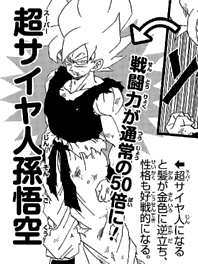 |
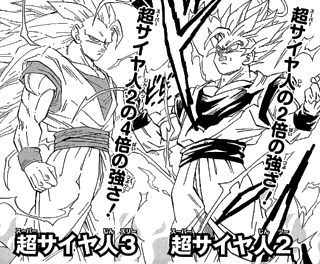 |
On p.63 it describes the Potara fusion as being closer to multiplication rather than simple addition in the way it increases power. A graphical depiction of this infers that Vegetto’s battle power is equivalent to Goku’s battle power multiplied by Vegeta’s. Also according to the introduction of the Super Exciting Guide′s training section, all the information in it is based on data that was supervised by Toriyama, though we have no idea how extensive this supervision was.
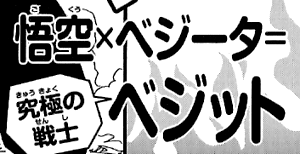
Battle Powers in Weekly Shōnen Jump
1989
In 1989, the 31st issue of Weekly Shōnen Jump featured a special section on battle powers, along with a quiz-based Dragon Ball contest and a feature on the “Jump Anime Carnival”, which was where the Toriyama anime Kosuke-sama premiered. All three of these special sections were in the form of pull-out posters. The battle power section is called “Final Warriors-Great Collection!! Cards”. The introduction is in the form of Bulma with her scouter. She explains that each of the characters are given a number indicating their strength, as well as a symbol showing what martial arts school they belong to (such as the Turtle school or Crane school). These numbers are referred to as daitai no sentō-nōryoku (“approximate battle ability”), rather than the usual sentō-ryoku (“battle power”). It should be noted that the term “battle ability” is actually used in the manga a few times as a synonym for “battle power”, such as when Vegeta reads Goku as being 5,000.
However, no source for these numbers is mentioned. With the exception of Kame-Sen’nin, all of these battle ability numbers given for the characters here match those later given for them in Daizenshuu 7 (1996). Since this issue came out seven years before Daizenshuu 7, it seems that this was either a source for the Daizenshuu 7 list, or they share the same source. The games Dragon Ball Z: Kyōshū Saiya-jin (1990) and Dragon Ball Z: Sūpā Saiya Densetsu (1992) also use several of these battle powers.
When this issue came out, the battle with Vegeta was still in progress (the issue itself contains the struggle between Goku’s Kamehameha and Vegeta’s Gyarik-Hō), so all battle powers were intended to be for the battle with Vegeta and Nappa, unless otherwise noted.
This is taken from his battle power while firing the Masenkō. In Daizenshuu 7 his battle power for the battle with the Saiyan is given as simply “2,800”, with no clarification that is “over” that number.
This was reused in Daizenshuu 7.
This would be Goku during the 23rd Tenka’ichi Budōkai. It is much higher than 416, his regular battle power during the fight with Raditz five years later, but it is slightly lower than his battle power while firing the Kamehameha then (“924 and rising”). This would work if it is his battle power while firing the Super Kamehameha during his fight with Piccolo, but nothing like that is mentioned.
In Daizenshuu 7, this is rounded down to simply 8,000.
This number appears to be original to this chart. It is lower than Demon King Piccolo’s, even though God is supposed to be stronger than the demon king. Since all of these figures are supposed to be during the battle with Vegeta, this number would only work if God had gotten much weaker between Goku’s battle with Demon King Piccolo and the battle with Vegeta.
Demon King Piccolo/Ma Junior: 3,500
Raditz: 1,500
Nappa: 4,000
All of these figures are the same as in Daizenshuu 7.
It notes that “his strength is unfathomable…!!”. As mentioned earlier, this was all printed while the Vegeta fight was still going on.
This is her battle power during the 23rd Tenka’ichi Budōkai. The Japanese Wikipedia page for Chi-Chi claims that a 1990 special issue of V-Jump gives Chi-Chi’s battle power as 137, noting that she is on par with Kame-Sen’nin.
Tenshinhan: 1,830
Yajirobe: 970
Kuririn: 1,770
Yamcha: 1,480
Yajirobe’s battle power is the only one not in Daizenshuu 7. Again, these would all be from during the fight against Vegeta and Nappa.
This would be Cyborg Tao Pai-pai to be exact (going by the picture).
This is another one which was reused in Daizenshuu 7.
The picture would seem to indicate that this is from his stand against Demon King Piccolo. Daizenshuu 7 lists Kame-Sen’nin as being at 139 during the 22nd Tenka’ichi Budōkai. The text says that “he fires the original Kamehameha“, so perhaps this is supposed to be his Kamehameha‘s power, or to indicate that he was stronger during his fight with the demon king than he was at the tournament?
Another original figure that was not reprinted in Daizenshuu 7. In the manga, Karin tells Goku that he has “almost surpassed him (Karin)” after the 22nd Tenka’ichi Budōkai, so this fits with Goku being at 180 during the tournament.
This is extremely high, considering that God is given as being only at 220, and God is stronger than Mister Popo by his own admission. Since these numbers are generally from the battle with Vegeta and Nappa, perhaps Mister Popo became more powerful after training the Earthling warriors for a year? Or since neither this battle power nor God’s were reused for Daizenshuu 7, maybe both were later deemed simply mistakes?
This figure is original to this issue of Jump and was not reused in Daizenshuu 7. It puts Kaiō as being equal to Piccolo during his fight with the Saibaimen and Nappa.
1991
Among the opening pages of Weekly Shōnen Jump 1991 No. 25 (released 28 May 1991, also containing Dragon Ball chapter 326) is a three-page promotional spread for the then-upcoming fifth Dragon Ball Z film: The Incredible Strongest vs Strongest, featuring Freeza’s brother, Coola. The spread includes Akira Toriyama’s designs for the characters, along with exclusive background information (not mentioned during the film itself!) for each character… as well as battle power readings!
Wanted to make sure I grabbed my own copy of WJ 1991 No. 25 (released May 28, 1991), which is the primary source for the background info on Coola’s henchmen. This issue also contains a massively impressive Dragon Ball chapter: 326, where Freeza gets sliced by his own attack. pic.twitter.com/A8fBill5OT
— Mike (@VegettoEX) September 22, 2022
Neiz: 163,000
Dore: 185,000
Battle Powers in V-Jump
V-Jump, Debut Issue
The very first issue of V-Jump from late 1990 — the actual debut issue from its first (of two) trial runs before more formally launching as a monthly magazine in 1993 — featured a page on the battle powers of the characters during the early portion of the battle with Freeza. At this time, the manga around the point where Freeza transforms into his third form. Besides listing some of the battle powers stated in the manga, such as Freeza being at 530,000 in his first form, the page gives a few new battle powers. Vegeta is pegged at 250,000, making him almost ten times as strong as he was before recovering from his fight with Reacoom. Meanwhile, Gohan is said to be 200,000 normally, but it notes that he can get far stronger, so it gives his overall battle power as simply “?”.
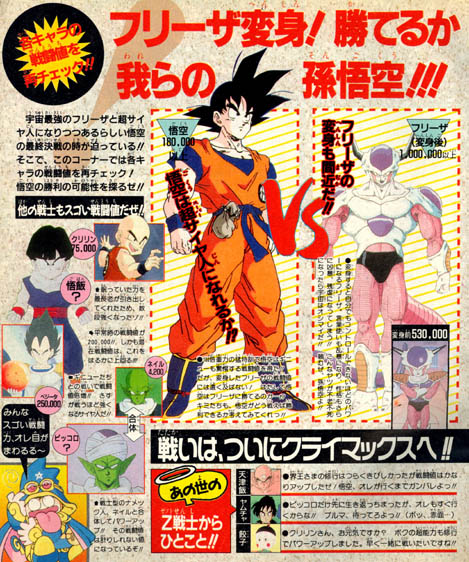
Kuririn is said to be 75,000, much stronger than during the fight with Gurd when it was only “over 10,000”. This touches on an unresolved issue from the manga: before beginning to fight Freeza, Vegeta says that both Gohan and Kuririn’s battle powers are steadily rising. As a half Saiyan, Gohan gets stronger each time he recovers from the brink of death, but why would Kuririn be getting constantly stronger? Does he improve that much simply by fighting with strong enemies, or does the power-up he received from the Eldest take awhile before it takes full effect?
In addition to the battle powers, at the bottom of the page is a section where Tenshinhan and the others at Kaiō’s give their comments on the battle with Freeza. Tenshinhan says that he has gotten much stronger. Yamcha asks Bulma to wait for him. Chiaotzu wants to know if Kuririn is doing well. Also of note on this page is that it incorrectly gives Nail’s battle power as 4,200 rather than 42,000, which is clearly a typo more than a miscalculation.
Gohan, normal: 200,000
Gohan, emotional: “?”
Kuririn, after fighting Gurd: 75,000
V-Jump, July 2004 Issue
The Sony PlayStation 2 era of video games were immensely huge for the franchise. The eponymous Dragon Ball Z game series (released internationally under the Budokai subtitle, separate from the Sparking! / Budokai Tenkaichi trilogy that would follow it) were best-sellers not just in Japan, but especially in North America and Europe. The marketing hype that was put into Shueisha properties could be overwhelming at times, with multiple character announcements each month, sometimes each week!
In anticipation of Dragon Ball Z 3 (Budokai 3) set to be released that year, the July 2004 issue of V-Jump heavily promoted three movie-exclusive characters that would be making their 3D fighting game debut: Coola (from Dragon Ball Z Movie 5), Broli (primarily from Dragon Ball Z Movie 8), and Gogeta, the dance fusion product of Goku and Vegeta (from Dragon Ball Z Movie 12).
The “estimated battle power” for Coola is listed at 470,000,000 which would place him roughly four times as powerful as Freeza. Broli is listed at 1.4 billion which is roughly ten times as powerful as Son Goku was during his battle as a Super Saiyan against Freeza. Finally, Gogeta is listed at 2.5 billion.
There must be something about Japanese battle power fans in particular where they exclusively scan things in black-and-white. Another classic example is this DBZ3 coverage from the July 2004 issue of V-Jump which is super widespread as a black-and-white version. pic.twitter.com/HJJAZ5HHDV
— Mike (@VegettoEX) July 17, 2023
Battle Powers in Movie Pamphlets
Each theatrical Dragon Ball film had a special pamphlet produced to go alongside its run, which were available for purchase at cinemas or by mail during this period. Each pamphlet was actually a dual, or even triple-feature book, since each of the festivals would screen multiple movies alongside each other.
The Summer 1990 “Toei Anime Fair” opened on on 07 July 1990, and was dubbed “Akira Toriyama: The World”. The three features screened were all adaptations of Akira Toriyama works: the third Dragon Ball Z movie, a Pink adaptation, and a Kennosuke-sama adaptation. The Dragon Ball Z movie portion of the pamphlet contained a three-page spread detailing characters from both the regular series as well as movies along with their respective battle powers.
While some of these battle powers were those either already stated in the series proper, or published in Weekly Shōnen Jump, the pamphlet states that the majority were new original “Battle Points” taken from Bandai’s “Dragon Ball Carddass” series. The majority of the Dragon Ball Z battle powers are taken from the “VS Vegeta Compilation” and the beginning of the “VS Freeza Compilation”, specifically sets 3, 4, and 5 which were released in November 1989, April 1990, and July 1990, respectively.
This unfortunately creates conflicts for certain characters, and in general calls into question the use of these “Battle Points” as anything that should be directly associated with actual battle powers from the series. As both the “Dragon Ball Carddass” series and manga serialization progressed there became a drastic difference between the “Battle Points” and “Battle Powers” used within the two mediums. For example, the “Battle Point” with available multipliers used in the Carddass series for Super Saiyan Son Goku is 2.7 million (Card No. 338), whereas in every other publication it is stated to be 150 million. In addition, both Freeza and Coola are listed with peak “Battle Points” of 2.7 million (with available multipliers), even though full power Freeza is listed in Daizenshuu 7 at 120 million, and Coola is inherently stronger than Freeza. Therefore, you may decide that any battle powers listed below should be used with caution, especially those that conflict with previously established battle powers.
Goku and Friends
The battle powers listed below are taken from various points at the beginning of Dragon Ball Z, with a few coming from the end of Dragon Ball. Tenshinhan is the only one with a battle power that was previously stated in Weekly Shōnen Jump, while everyone else appears to be gauged off of some semi-educated guesses, although at different points in the series. For instance, Goku’s battle power of 10,000 would place it somewhere at the end of his battle with Vegeta, where his full power was stated to be over 8,000, and before his battle power of 90,000 on Planet Namek.
Battle powers, such as Yamcha’s, Kuririn’s, Chiaotzu’s, and Yajirobe’s, all greatly conflict with those stated in Weekly Shōnen Jump and Daizenshuu 7. Yajirobe’s final known battle power comes from the battle with Vegeta, which is said to be 970, yet here he’s listed at 2,100, even though as far it’s shown in the series he never trains again following that battle. Oddly, Chiaotzu’s battle power is taken from the end of Dragon Ball, while Kuririn’s appears to fall more inline with his battle power on Planet Namek. Yamcha on the other hand doesn’t even have any Carddass cards available beyond the end of Dragon Ball, and this is the highest battle power listed for Yamcha anywhere. In addition, if Chi-Chi were actually 300 at the beginning of Dragon Ball Z, then she would be nearly as strong as Goku with heavy clothes on.
Son Gohan: 6,000 [Set 4, Card No. 129]
Chi-Chi: 300 [Set 4, Card No. 168]
Kuririn: 5,000 [Set 5, Card No. 177]
Oolong: 10
Pu’er: 10
Yamcha: 1,900
Bulma: 12 [Set 4, Card No. 165]
Chiaotzu: 130 [Set 2, Card No. 61]
Tenshinhan: 1,830 [Set 3, Card No. 117]
Ma Junior: 8,200 [Set 5, Card No. 176]
Lunch: 18
Yajirobe: 2,100 [Set 4, Card No. 144]
The People Who Watch Goku
This is the first battle power ever listed for Gyūmaō, which places him above his old master, Kame-Sen’nin, who himself has become significantly stronger since his battle with Demon King Piccolo. While Kaiō’s battle power appears to be taken from Weekly Shōnen Jump, those listed for Karin, Mister Popo, and God seem to completely contradict this. Mister Popo is the most obvious contradiction, as he is listed at 1,030 in Weekly Shōnen Jump while being listed here at 300. This seems to fall more in line with God’s statement that he is stronger than Mister Popo, although God’s battle power has also been adjusted to possibly be closer to Demon King Piccolo. Battle powers for Enma-daiō, Bubbles, and Gregory are all original to this publication.
Kame-Sen’nin: 350 [Set 1, Card No. 5]
Karin: 290
Mister Popo: 300
God: 400 [Set 1, Card No. 25]
Enma-daiō: 1,300 [Set 3, Card No. 121]
Bubbles: 1,000
Gregory: 1,100
Kaiō: 3,500 [Set 3, Card No. 113]
Saiyan Warriors
While Raditz remains at his normal 1,500 here, Nappa has increased from a battle power of 4,000 set in Weekly Shōnen Jump, and later carried over into Daizenshuu 7, to 4,500. However, an earlier Carddass card (No. 99) does establish Nappa as having a battle power of 4,000 prior to his arrival on Earth. Apparently he gained 500 while sleeping in a space pod? Vegeta’s battle power is listed as slightly lower than that stated in the manga, where Dodoria says that Vegeta was barely 18,000 when he went to Earth. This battle power also contradicts Zarbon’s statement that when Vegeta arrived on Planet Namek that he had become stronger than both himself and Dodoria, which are listed as being stronger than Vegeta below.
There is a Carddass card (No. 107) for the Illusion Saiyans that Tenshinhan and the others face while training with God, but it lists them with a battle power of 2,240 each, so it’s unclear where the 3,000 came from. The Saibaimen seem to fall inline with previously stated battle powers in other publications, but they do have multiple Carddass cards with various battle powers, such as 1,050, 1,200, and 1,300.
Nappa: 4,500 [Set 4, Card No. 154]
Vegeta: 16,000 [Set 5, Card No. 180]
Illusion Saiyans: 3,000 (each)
Saibaiman: 1,300 [Set 4, Card No. 152]
Princess Snake
Her battle power is original to this publication, but appears to be based around Goku’s battle power while he traveled along Snake Road.
Alien Warriors
All of these battle powers are lower than those officially listed in Daizenshuu 7. Kewi states in the manga that Vegeta and himself had roughly the same battle power when Vegeta left for Earth, but he is listed here as being about half as strong as Vegeta. Freeza is listed here at only 85,000, which one could equate to him simply using a small portion of his first form power. However, this simply is not the case, as Freeza in his final form is listed within the Carddass series at 2.7 million. Freeza clearly states in the manga that his battle power is 530,000 in his first form and Daizenshuu 7 lists Freeza in his final form, using 100% of his full power, at 120 million. Overall, Freeza’s battle powers seem well out of proportion to those stated in the manga and calculated in Daizenshuu 7.
Dodoria: 15,000 [Set 5, Card No. 192]
Zarbon: 17,000 [Set 5, Card No. 190]
Freeza (first form): 85,000 [Set 5, Card No. 183]
Namekians
Muri’s battle power is original to this publication, but appears to be based around the younger Namekian warriors being listed at 3,000. At the point this pamphlet was published, Nail and the Eldest had no established battle powers. Nail did later receive a Carddass card (Set 6, Card No. 227) with a battle power of 42,000, which matched that stated in the manga.
Nail: It is not yet clear.
The Eldest: It is not yet clear.
Garlic and Trio
The battle powers listed in this pamphlet for Ginger, Sansho, and Nicky appear to be based on Goku and Piccolo’s battle powers prior to their battle with Raditz. The specific Carddass card used for Garlic Jr.’s battle power is titled “Garlic and Trio” and lists the group with a battle power of 1,450, but it isn’t too clear on whether this is their combined battle power. Since the card lists them as a group, it could be hypothesized that Garlic Jr.’s battle power is actually 400, which can be reached by subtracting the trio’s battle powers from the group’s 1,450. This would put him more on-par with God, but the pamphlet seems to think differently.
Ginger: 350
Sansho: 350
Nikki: 350
Dr. Uiro and Brutal Warriors
These battle powers are original to this publication.
Dr. Kochin: 8
Misokattsun: 4,300 [Set 5, Card No. 203]
Ebifuriya: 7,500 [Set 5, Card No. 205]
Kishime: 7,000 [Set 5, Card No. 204]
Bioman: 1,000 [Set 5, Card No. 206]
Space Crusher
These battle powers are original to this publication. However, the pamphlet appears to have accidentally swapped the appropriate “Battle Points” for Daiz and Kakao from their original Carddass cards. This has been corrected below.
Daiz: 13,000 [Set 5, Card No. 200]
Kakao: 8,400 [Set 5, Card No. 199]
Rezun: 8,000 [Set 5, Card No. 197]
Rakasei: 7,600 [Set 5, Card No. 201]
Amond: 9,100 [Set 5, Card No. 198]
Pilaf and Underlings
These battle powers are original to this publication. While this trio does have a Carddass card, it doesn’t have any battle power associated with it. These battle powers do seem a bit high, considering a normal human has a battle power of roughly 5 and Goku has a battle power of 10 at the very beginning of the series. However, one could argue that although they have higher than average battle powers they lack any proper battle skills, which is why they typically resort to using tricks and/or mechanical devices to achieve their goals.
Shuu: 20
Mai: 20
Formidable Opponents of the Tenka’ichi Budōkai
These battle powers are original to this publication, which appear to be based around Kame-Sen’nin’s battle power being less than 139 at the time of the 21st Tenka’ichi Budōkai.
Lan-Fan: 80 [Set 2, Card No. 66]
Namu: 100 [Set 1, Card No. 14]
Giran: 100
Red Ribbon Army
These battle powers are original to this publication. Commander Red and General Blue are the only two to have actual Carddass cards, so it appears that the battle powers for the remaining Red Ribbon Army members are based off of these, with respect to insinuated gaps in power shown in the manga.
Colonel Silver: 200
Captain Violet: 150
General White: 150
General Blue: 180 [Dragon Ball 90 Set, Card B-4]
Assistant Black: 150
Commander Red: 100 [Dragon Ball 90 Set, Card B-3]
Tsuru-Sen’nin Brothers
It seems rather unlikely that Tao Pai-pai would have a battle power of 240 when Weekly Shōnen Jump lists him with a battle power of 210 as a cyborg at the 23rd Tenka’ichi Budōkai. However, Tsuru-Sen’nin’s battle power is fairly in line with that listed in Weekly Shōnen Jump and later included in Daizenshuu 7.
Tsuru-Sen’nin: 130 [Set 2, Card No. 57]
Demon Clan
Weekly Shōnen Jump and Daizenshuu 7 list both Goku and Demon King Piccolo with battle powers of 260 during their battle, so it is unclear what a battle power of 500 for Demon King Piccolo is based on. It would also stand to reason that Tambourine and Drum are listed too high in comparison to Demon King Piccolo. Overall, these battle powers don’t seem to fit in with the conventional, officially listed battle powers.
Piano: 180
Tambourine: 340 [Set 2, Card No. 70]
Drum: 280



